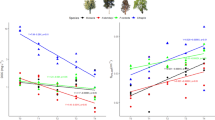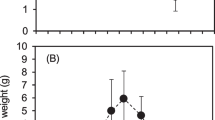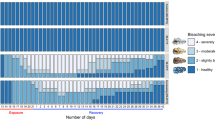Abstract
Since water temperature is a major factor influencing the development and the geographic distribution of aquatic mosses, experiments were performed to study the influence of temperature on both the physiology and the metal uptake-release ability of the species Rhynchostegium riparioides. Experiments were carried out in the laboratory in a flow-through system contaminated for 12 days by a copper solution with a mean concentration of 80 μg/L and then followed by a post-exposure period of 10 days. Denaturation of chlorophyll pigments was observed at 29°C for both the control and the contaminated organisms. The increase of water temperature from 7 to 29°C led to a decrease in moss vitality measured by CO2 assimilation but did not affect Cu uptake-release kinetics. Therefore the accumulation of Cu is not directly related to photosynthesis. Since Cu uptake by the mosses over the 22 days of exposure was not significantly influenced by water temperature, the results support the use of Rhynchostegium riparioides as an indicator of copper pollution in cases of thermal pollution or during different seasons.
Similar content being viewed by others
References
American Public Health Association (1975) Standard methods for the examination of water and wastewater, 14 ed. Washington, DC, 1193 pp
Axelsson L (1988) Changes in pH as a measure of photosynthesis by marine macroalgae. Marine Biol 97:287–294
Breuer K, Melzer A (1990) Heavy metal accumulation (lead and cadmium) and ion exchange in three species of Sphagnaceae. I: Main principles of heavy metal accumulation in Sphagnaceae. Oecologia 82:461–467
Caines LA, Watt W, Wells DED (1985) The uptake and release of some trace metals by aquatic bryophytes in acidified waters in Scotland. Environ Pollut 10 (B):1–18
Dilks TJK, Proctor MCF (1975) Comparative experiments on temperature responses of bryophytes: Assimilation, respiration and freezing damage. J Bryol 8:317–336
Empain A (1977) Ecologie des populations bryophytiques aquatiques de la Meuse, de la Sambre et de la Somme. Relation avec la qualité des eaux, écophysiologie comparée et étude de la contamination par métaux lourds. Mém Th Doct Sc Bot, Univ. Liège, 179 pp
Glime JM, Acton DW (1979) Temperature effects on assimilation and respiration in the Fontinalis duriaei-periphyton association. Bryologist 82, 3:382–392
Glime JM, Witt DH (1984) The physiological adaptations of aquatic musci. Lindbergia 10:41–52
Golterman HL (1969) Methods for chemical analysis of fresh waters. International Biological Programme, Blackwell Scientific Publications, Oxford and Edinburg
Gonçalves EPR, Bioaventura RAR, Mouvet C (1992) Sediments and aquatic mosses as pollution indicators for heavy metals in the Ave river basin (Portugal). Sci Total Environ 114:7–24
Haseloff HP, Winkler S (1980) Influence of heavy metal ions on the gas exchange of mosses. Cryptog Bryol Lichenol 1, 1:53–65
Jackson PP, Robinson NJ, Whitton BA (1991) Low molecular weight metal complexes in the freshwater moss Rhynchostegium riparioides exposed to elevated concentrations of Zn, Cu, Cd and Pb in the laboratory and field. Environ Exp Bot 31, 3:359–366
Kelly MG, Girton C, Whitton BA (1987) Use of moss-bags for monitoring heavy metals in rivers. Water Res 21, 11:1429–1435
Lanaras T, Moustakas M, Symeodinis L, Diamantoghou S, Karataglis S (1993) Plant metal content, growth responses and some photosynthetic measurements on field-cultivated wheat growing on ore bodies enriched in Cu. Physiol Plant 88:307–314
Lopez J, Carballeira A (1993) Interspecific differences in metal bioaccumulation and plant-water concentration ratios in five aquatic bryophytes. Hydrobiologia 263:95–107
Meharg AA (1993) The role of the plasmalemma in metal tolerance in angiosperms. Physiol Plant 88:191–198
Mersch J, Johansson L (1993) Transplanted aquatic mosses and freshwater mussels to investigate the trace metal contamination in the rivers Meurthe and Plaine, France. Environ Technol 14:1027–1036
Mersch J, Dubost N, Pihan JC (1993) Comparaison de plusieurs supports analytiques inertes et biologiques pour apprécier la contamination métallique de la retenue du site électronucléaire de Cattenom, France. Annls Limnol 29 (3–4):325–337
Moore JW, Ramamoorthy S (1984) Heavy metals in natural waters. Applied monitoring and impact assessment. Springer-Verlag, NY
Mouvet C (1984) Métaux lourds et mousses aquatiques. Spéciation physico-chimique, bioaccumulation et toxicité. Mém Th Doct Sc Bot, Univ Liège, 157 pp
Mouvet C (1985) The use of aquatic bryophytes to monitor heavy metals pollution of freshwaters as illustrated by case studies. Verh Internat Verein Limnol 22:240–2425
Mouvet C (1986) Métaux lourds et mousses aquatiques. Synthèse méthodologique. Report to the Agence de l'Eau Rhin-Meuse, B.P. 19, Rozerieulles, F-57161 Moulins-les-Metz, France
Mouvet C, Morhain E, Sutter C, Couturieux N (1993) Aquatic mosses for the detection and follow-up of accidental discharges in surface waters. Water Air Soil Pollut 66:333–348
Ouzounidou G, Lannoye R, Karataglis S (1993) Photoacoustic measurements of photosynthetic activities in intact leaves under copper stress. Plant Sci 89:221–226
Pickering DC, Puia IL (1969) Mechanism for the uptake of zinc by Fontinalis antipyretica. Physiol Plantarum 22:653–661
Poskuta JW (1991) Toxicity of heavy metals to growth, photosynthesis and respiration of Chlorella pyrenoidosa cells grown either in air or 1-percent CO2. Photosynthetica 25, 2:181–188
Richardson DHS (1981) The biology of mosses. Blackwell Scientific Publications, Oxford, Edinburg
Say PJ, Harding JPC, Whitton BA (1981) Aquatic mosses as monitors of heavy metal contamination in the river Etherow, Great Britain. Environ Pollut (B), 2:295–307
Sérgio C, Seneca A, Maguas C, Branquinho C (1992) Biological responses of Sphagnum auriculatum Schimp. to water pollution by heavy metals. Cryptog Bryol Lichenol 13, 2:155–163
Sommer C, Winkler S (1982) Reaktionen im gaswechsel von Fontinalis antipyretica Hedw. nach experimentellen belastungen mit schwermetallverbindungen. Arch Hydrobiol 93, 4:503–524
Starodub ME, Wong PTS, Mayfield CI (1987) Short term and long term studies on individual and combined toxicities of copper, zinc and lead to Scenesdesmus quadricauda. Sci Total Environ 63:101–110
Tyler G (1990) Bryophytes and heavy metals: A literature review. Bot J of the Linnean Soc 104:231–253
Vray F, Baudin JP, Svadlenkova M (1992) Effects of some factors on uptake and release of Ru-106 by a freshwater moss, Platyhypnidium riparioides. Arch Environ Contam Toxicol 23, 2:190–197
Wehr JD, Whitton BA (1983) Accumulation of heavy metals by aquatic mosses, 2: Rhynchostegium riparioides. Hydrobiologia 100:261–284
Wehr JD (1986) Ecological factors relating to morphological variation in the aquatic moss Rhynchostegium riparioides (Hedw.) C. Jens. J Bryol 14:269–280
Wehr JD, Kelly MG, Whitton BA (1987) Factors affecting accumulation and loss of zinc by the aquatic moss Rhynchostegium riparioides (Hedw.) C. Jens.. Aquatic Bot 29:261–274
Author information
Authors and Affiliations
Rights and permissions
About this article
Cite this article
Claveri, B., Mouvet, C. Temperature effects on copper uptake and CO2 assimilation by the aquatic moss Rhynchostegium riparioides . Arch. Environ. Contam. Toxicol. 28, 314–320 (1995). https://doi.org/10.1007/BF00213108
Received:
Revised:
Issue Date:
DOI: https://doi.org/10.1007/BF00213108




